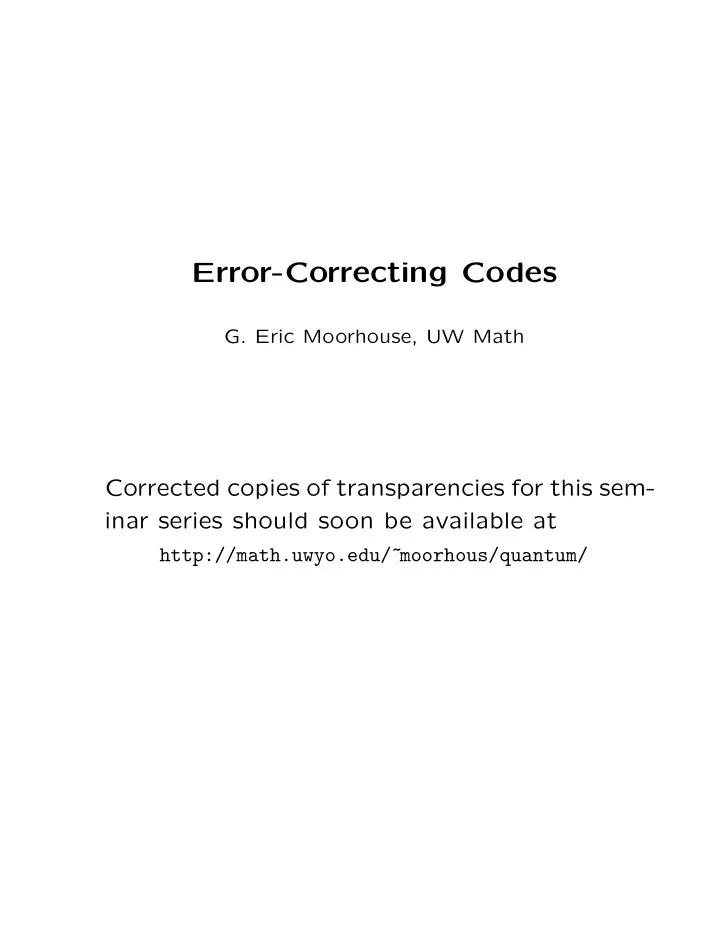

Error-Correcting Codes G. Eric Moorhouse, UW Math Corrected copies of transparencies for this sem- inar series should soon be available at http://math.uwyo.edu/~moorhous/quantum/
References F.J. MacWilliams and N.J.A. Sloane, The North- Theory of Error-Correcting Codes, Holland, 1977. J.H. van Lint, Introduction to Coding Theory, 2nd ed., Springer-Verlag, 1992.
Goal of Coding Theory Digital information in the real world is subject to errors, i.e. alteration due to unreliability of storage media and interference in communi- cations channels. The goal of coding theory is to represent dig- ital information in a form which allows for the recovery of the original data from its cor- rupted form, if the number of errors is not too large. This requires that some redundancy be incor- porated into the stored information.
Key People Richard Hamming (1915–1998), pioneer in computer design and error-correcting codes. Claude Shannon (1916–?), founder of Infor- mation Theory, researcher at Bell Telephones 1941-1972. Both Hamming and Shannon were involved in the Manhattan Project.
Alphabet and Words Information is stored and transmitted as a stream of letters from a chosen alphabet F . Most popular is the binary alphabet F = { 0 , 1 } . More generally, F = { 0 , 1 , 2 , . . . , p − 1 } with ad- dition and multiplication mod p (where p is a prime) is popular because F is a field. In this case F n = { ( a 1 , a 2 , . . . , a n ) : a i ∈ F } is an n -dimensional vector space over F . A word of length n is a string of n characters from the alphabet F . If | F | = q then there are q n words of length n . These are identified with the vectors of F n . A code of length n is a subset C ⊆ F n . Ele- ments of C are codewords. If F = { 0 , 1 } then C is a binary code.
Example 1: Parity Check Codes The following binary code C 1 = { 00000 , 00011 , . . . , 11110 } of length 5 is formed by append- ing a parity check bit to the end of each mes- sage word. Message word Codeword 0000 00000 0001 00011 0010 00101 0011 00110 0100 01001 0101 01010 0110 01100 0111 01111 1000 10001 1001 10010 1010 10100 1011 10111 1100 11000 1101 11011 1110 11101 1111 11110 Using the code C 1 , we can detect up to one bit error during transmission, but we cannot correct any errors.
Example 2: 3-Repetition Codes The following binary code C 2 of length 12 is formed by repeating each message word three times. Message word Codeword 0000 0000 0000 0000 0001 0001 0001 0001 0010 0010 0010 0010 0011 0011 0011 0011 0100 0100 0100 0100 0101 0101 0101 0101 0110 0110 0110 0110 0111 0111 0111 0111 1000 1000 1000 1000 1001 1001 1001 1001 1010 1010 1010 1010 1011 1011 1011 1011 1100 1100 1100 1100 1101 1101 1101 1101 1110 1110 1110 1110 1111 1111 1111 1111 Using this code we can correct up to one bit error during transmission.
This gain comes at a price: C 2 has information 12 = 1 4 rate 3 , lower than the information rate of C 1 which is 4 5 . The information rate of a binary code is the ratio of the number of significant bits of in- formation in each word, to the total length of each word. More generally for an alphabet of size | F | = q , the information rate of a code C of length n over F is log q |C| . n We seek codes with (i) high information rate, and (ii) high error-correcting capability. The goal (ii) requires that codewords be ‘far apart’ from each other.
Hamming Distance The Hamming distance between two words x, y ∈ F n , denoted d ( x, y ), is the number of coordinate positions in which they differ. E.g. d (10010 , 00111) = 3. The minimum distance of a code C ⊆ F n is the minimum of d ( x, y ) for all x � = y in the code C . Theorem. A code C corrects e errors if and only if the minimum distance of C is at least 2 e +1 . Suppose C has minimum distance at Proof. least 2 e +1. If a codeword x ∈ C suffers at most e bit errors, the corrupted word x ′ satis- fies d ( x ′ , x ) ≤ e . And x is the only codeword
Recommend
More recommend